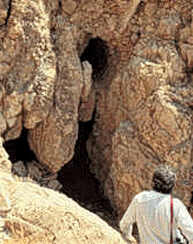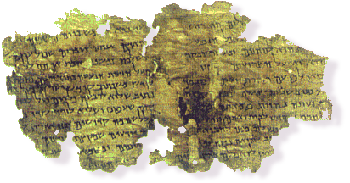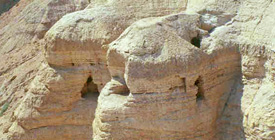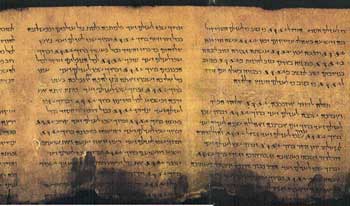... E NAS PAREDES DAS "CAVERNAS" DO ESPAÇO-TEMPO-HISTÓRIA, SURGEM OS BLOGS, QUE COMUNICAM... ESSÊNCIA DA INTELIGÊNCIA... QUE BUSCAM... QUE INTERAGEM... NA ESPERANÇA DE AMPLIAR OS RALACIONAMENTOS À SEMELHANÇA DO CRIADOR... NOS APROXIMAMOS...
domingo, 22 de junho de 2008
Transmissão ao vivo ... INTERNET
http://www.mogulus.com/theoterapia
THEOTERAPIA - Terapia de Deus...
"REFLEXÃO SOBRE A EXISTÊNCIA, O SER, O CRIADOR, A AUTO-REVELAÇÃO DO CRIADOR, SUA PALAVRA, A INTELIGÊNCIA DA COMUNICAÇÃO, A LINGUAGEM E A CIÊNCIA HERMENÊUTICA, PRINCÍPIOS E DIRETRIZES DAS ORIENTAÇÕES DO CRIADOR PARA O SER HUMANO..."
"CRÍTICA DA ARTE: INDICAÇÃO DE LITERATURA, FILMES, AUTORES, EDITORAS, PRODUÇÕES, ARTE EM GERAL"
"COSMOVISÃO, SISTEMA DE CRENÇA, RELIGIÃO, MORAL, ÉTICA, FAMÍLIA, VIDA EM SOCIEDADE"
Dia: Todos os dias.
Horário: 24:00 hrs ou ... O TEMPO TODO...
"U WELCOME HERE... !!!"
Heber...
quinta-feira, 19 de junho de 2008
Estudos Básicos Teológicos...
~ CURSO BÁSICO TEOLÓGICO ~
MÓDULO UM:
INTRODUÇÃO BÍBLICA e ANTIGO TESTAMENTO - A origem do Universo: Visão Bíblica x Teoria da Evolução; Geografia e Arqueologia Bíblica: Antigo Oriente Próximo, Crescente Fértil, a Palestina de Abraão a Malaquias; Principais Impérios Mundiais dos tempos bíblicos: Impérios Egípcio, Assírio, Babilônico, Persa, Grego e Romano; Formação da Nação de Israel e Conquista de Canaã; Divisão do Reino de Israel; Os Juizes, Reis e Profetas de Israel; Cronologia Bíblica. O Cânon do Antigo e Novo Testamentos; A Papirologia; O período interbíblico; Livros Apócrifos do Antigo e Novo Testamentos.
MÓDULO DOIS:
NOVO TESTAMENTO - Estudo da origem, da forma e do conteúdo dos Evangelhos. Estudo da vida e do ministério de Jesus Cristo dentro do seu contexto histórico, social, cultural e religioso, servindo de padrão para fé e prática cristã. Estudo dos Atos do Senhor Jesus Cristo, operando mediante o Espírito Santo através dos apóstolos, com o propósito da expansão do reino de Deus. Estudo do começo e expansão da Igreja Cristã (de Jerusalém até os "confins da terra"). Cartas Paulinas e Gerais - Um breve estudo da vida de Paulo, seu ministério e do contexto histórico, social, cultural e religioso da época em que foi escrita cada carta. Estudo indutivo, exegético e explicativo de algumas cartas.
ARQUEOLOGIA BÍBLICA - "Arque" (Origem, princípio); "Logia" (Estudo, razão), investigação dos casos de Qunram e das recentes pesquisas sobre o Exodo, conforme vídeos no meu ORKUT. Investigações em geral dos sítios arqueológicos a respeito do mundo bíblico.
MÓDULO TRÊS:
HERMENÊUTICA - Considerações gerais relacionadas com o estudo da bíblia e apresentação e aplicação de diversos métodos no estudo bíblico. Estudo dos princípios básicos e das regras de interpretação bíblica, considerando seu contexto histórico, literário e gramatical. Análise de textos controvertidos.
TEOLOGIA SISTEMÁTICA A - A existência de Deus, os atributos de Deus, a providência divina, a criação, a Trindade, os Anjos, Satanás e os demônios, a criação do homem, a essência da natureza humana, o pecado e as alianças entre Deus e o homem.
HOMILÉTICA - Estudo da arte anunciar o Evangelho, "KERIGMA", anúncio da Palavra de Deus como Palavra de Deus. Autoridade do AUTOR por ser AUTOR e o leitor como humilde aprendiz de DEUS, anunciar a Palavra de Deus, como profetas de Deus para o tempo do profeta.
MÓDULO OUATRO:
TEOLOGIA SISTEMÁTICA B - A pessoa de Cristo, a Expiação, Ressurreição e Ascensão, os Oficios de Cristo, a Obra do Espírito Santo, a graça comum, Eleição e reprovação, Regeneração, Conversão, Justificação, Adoção, Santificação, a Morte e o Estado Intermediário, a Glorificação.
LIDERANÇA CRISTÃ - Estudo dos princípios bíblicos da liderança sábia, coerente e eficaz. Administração sob a ótica da Palavra de Deus. Motivação-motivare-emoção = EU.
DISCIPULADO CRISTÃO - O discipulado no ministério cristão. Discipulado individual e em pequenos grupos, como começar, sendo servo, vivendo como servo, funcionando como servo.
MÓDULO CINCO:
TEOLOGIA SISTEMÁTICA C - A Igreja: Significado, natureza, características e propósitos. A Pureza e unidade da Igreja; O poder de Cristo e a Igreja seu corpo; Batismo e Ceia do Senhor; Adoração; A volta de Cristo; Escatologia; Juízo Final e Castigo Eterno; Novo Céu e Nova Terra.
TEOLOGIAS COMPARADAS - Estudo do fenômeno chamado "fé". Teologias, Estudo das grandes religiões mundiais, como: Hinduísmo, Budismo, Islamismo, Judaísmo, Cristianismo e suas ramificações.
MÓDULO SEIS:
LAR CRISTÃO - Estudo da visão cristã sobre o casamento, família e educação dos filhos. Dilemas e desafios da família moderna. Educação sexual e a família. O preparo para o casamento e o papel da igreja na formação e
manutenção da família. Solteiros, viúvos e órfãos, separados, disturbios da identidade humana, THEOTERAPIA.
ÉTICA CRISTÃ - Sistema de crença, eu profundo, moral, ética. Apresentação dos diversos sistemas éticos existentes. Definição de ética cristã e estudo de
questões fundamentais relacionados com ela. Estudo e debates de questões específicas, como: aborto, eutanásia, pena de morte, política, guerra, revolução sexual, casamento, família, divórcio, questões bioéticas, ecológicas, etc.
ACONSELHAMENTO PASTORAL - Estudo dos fundamentos do aconselhamento pastoral e sua prática, integrando alguns princípios terapêuticos básicos conforme a Palavra de Deus, Psiquê-Pneuma-Soma, Estudo do SER, o "eu" profundo, e a terapia de Deus, THEOTERAPIA.
Faça sua inscrição por internet: (VOCE É BEM VINDO SE QUISER ADICIONAR).
MSN: heber_zenun@hotmail.com
ORKUT: heber zenun
Skype: hbrznn
Email: hzenun@gmail.com
Estudos com atenção particular a cada aluno, e atendimento a todas as questões em particular visando o crescimento sob a condução e luz da Inerrante, Perfeita, Palavra de Deus, a Bíblia Sagrada, preservada especialmente por Deus para nosso bem e condução na Verdade - Salmo 119 - João 14:6
Investimento: Este ministério se mantém por ofertas voluntárias dos estudantes.
(Encontros também particulares para debates e estudos P2P - Em Florianópolis SC - Com agendamento).
Deus abençoe a todos que desejam com sinceridade servir ao SENHOR.
Heber, um servo.
(Esta grade de estudos tem por base mas não segue no seu todo a que é utilizada em nossa Faculdade Teológica - IBE SC - Nível Básico - Onde sou professor)
Se voce tiver oportunidade estude em nível universitário no IBE - Estudos todos os dias. Ou pode fazer o curso básico no IBE. Mas se não houver disponibilidade para estar fazendo estes cursos na escola, pode estudar desta forma pessoal via internet, onde sou o professor em particular.
Site do IBE:
http://www.institutobatista-sc.com.br/basicoteologico.php
domingo, 15 de junho de 2008
Pesquisas sobre EXODO BÍBLICO...
Podem visitar meu ORKUT... estão lá em 11 partes um interessante estudo arqueológico a respeito do EXODO BÍBLICO...
Agora já disponibilizei o video deste importantíssimo estudo arqueológico sobre o Exodo na íntegra legendado em português...
Todos são benvindos...
domingo, 8 de junho de 2008
Manuscritos do MAR MORTO
The Dead Sea Scrolls are a compilation of about 900 ancient documents that comprise the oldest known texts of the Old Testament and contain various psalms and stories not previously included in the Old Testament. They were discovered in eleven different caves on the shores of the Dead Sea in the mid-20th Century.
The scrolls contain text from the Hebrew Bible, including the last words of Joseph, Judah, Levi, Naphtali, and Amram (the father of Moses) and are the only known evidence of late Second Temple Jerusalem.
- Discovered between 1947 and 1956
- Believed to have been written between 200 B.C. and 68 C.E.
- Written on animal skins, papyrus and copper
- Written in Hebrew and Aramaic
- Scholars have identified the remains of 825 to 870 separate scrolls
- The Temple Scroll, found in Cave 11, is the longest scroll at 26.7 feet
- Provide an evolutionary link between Christianity and Judaism
The scrolls are believed to have been contained in a Jewish library that was hidden in the caves when the Roman army advanced on the rebel Jews.
Prophecies of Ezekiel, Jeremiah and Daniel that are missing from the Bible have been rediscovered in the scrolls. Previously unknown Psalms devoted to King David and Joshua, stories featuring Noah, Enoch and Abraham, including an explanation as to why God asked him to sacrifice his son, are also depicted in the scrolls.1.The Dead Sea Scrolls were discovered in eleven caves along the northwest shore of the Dead Sea between the years 1947 and 1956. The area is 13 miles east of Jerusalem and is 1300 feet below sea level. The mostly fragmented texts, are numbered according to the cave that they came out of. They have been called the greatest manuscript discovery of modern times. See a Dead Sea Scroll Jar.
 2. Only Caves 1 and 11 have produced relatively intact manuscripts. Discovered in 1952, Cave 4 produced the largest find. About 15,000 fragments from more than 500 manuscripts were found.
2. Only Caves 1 and 11 have produced relatively intact manuscripts. Discovered in 1952, Cave 4 produced the largest find. About 15,000 fragments from more than 500 manuscripts were found. 3. In all, scholars have identified the remains of about 825 to 870 separate scrolls.
4. The Scrolls can be divided into two categories—biblical and non-biblical. Fragments of every book of the Hebrew canon (Old Testament) have been discovered except for the book of Esther.
5. There are now identified among the scrolls, 19 copies of the Book of Isaiah, 25 copies of Deuteronomy and 30 copies of the Psalms .
6. Prophecies by Ezekiel, Jeremiah and Daniel not found in the Bible are written in the Scrolls.
7. The Isaiah Scroll, found relatively intact, is 1000 years older than any previously known copy of Isaiah. In fact, the scrolls are the oldest group of Old Testament manuscripts ever found.
8. In the Scrolls are found never before seen psalms attributed to King David and Joshua. 9.There are nonbiblical writings along the order of commentaries on the OT, paraphrases that expand on the Law, rule books of the community, war conduct, thanksgiving psalms, hymnic compositions, benedictions, liturgical texts, and sapiential (wisdom) writings.
9.There are nonbiblical writings along the order of commentaries on the OT, paraphrases that expand on the Law, rule books of the community, war conduct, thanksgiving psalms, hymnic compositions, benedictions, liturgical texts, and sapiential (wisdom) writings.
10. The Scrolls are for the most part, written in Hebrew, but there are many written in Aramaic. Aramaic was the common language of the Jews of Palestine for the last two centuries B.C. and of the first two centuries A.D. The discovery of the Scrolls has greatly enhanced our knowledge of these two languages. In addition, there are a few texts written in Greek.
11. The Scrolls appear to be the library of a Jewish sect. The library was hidden away in caves around the outbreak of the First Jewish Revolt (A.D. 66-70) as the Roman army advanced against the rebel Jews.
12. Near the caves are the ancient ruins of Qumran. They were excavated in the early 1950's and appear to be connected with the scrolls.
13. The Dead Sea Scrolls were most likely written by the Essenes during the period from about 200 B.C. to 68 C.E./A.D. The Essenes are mentioned by Josephus and in a few other sources, but not in the New testament. The Essenes were a strict Torah observant, Messianic, apocalyptic, baptist, wilderness, new covenant Jewish sect. They were led by a priest they called the "Teacher of Righteousness," who was opposed and possibly killed by the establishment priesthood in Jerusalem.
14. The enemies of the Qumran community were called the "Sons of Darkness"; they called themselves the "Sons of Light," "the poor," and members of "the Way." They thought of themselves as "the holy ones," who lived in "the house of holiness," because "the Holy Spirit" dwelt with them.
15. The last words of Joseph, Judah, Levi, Naphtali, and Amram (the father of Moses) are written down in the Scrolls. 16. One of the most curious scrolls is the Copper Scroll. Discovered in Cave 3, this scroll records a list of 64 underground hiding places throughout the land of Israel. The deposits are to contain certain amounts of gold, silver, aromatics, and manuscripts. These are believed to be treasures from the Temple at Jerusalem, that were hidden away for safekeeping.
16. One of the most curious scrolls is the Copper Scroll. Discovered in Cave 3, this scroll records a list of 64 underground hiding places throughout the land of Israel. The deposits are to contain certain amounts of gold, silver, aromatics, and manuscripts. These are believed to be treasures from the Temple at Jerusalem, that were hidden away for safekeeping.
17. The Temple Scroll, found in Cave 11, is the longest scroll. Its present total length is 26.7 feet (8.148 meters). The overall length of the scroll must have been over 28 feet (8.75m).
18. The scrolls contain previously unknown stories about biblical figures such as Enoch, Abraham, and Noah. The story of Abraham includes an explanation why God asked Abraham to sacrifice his only son Isaac.
19. The scrolls are most commonly made of animal skins, but also papyrus and one of copper. They are written with a carbon-based ink, from right to left, using no punctuation except for an occasional paragraph indentation. In fact, in some cases, there are not even spaces between the words.
20. The Scrolls have revolutionized textual criticism of the Old Testament. Interestingly, now with manuscripts predating the medieval period, we find these texts in substantial agreement with the Masoretic text as well as widely variant forms. 21. Some of the Dead Sea Scrolls actually appeared for sale on June 1, 1954 in the Wall Street Journal. The advertisement read — "The Four Dead Sea Scrolls: Biblical manuscripts dating back to at least 200 BC are for sale. This would be an ideal gift to an educational or religious institution by an individual or group. Box F206."
21. Some of the Dead Sea Scrolls actually appeared for sale on June 1, 1954 in the Wall Street Journal. The advertisement read — "The Four Dead Sea Scrolls: Biblical manuscripts dating back to at least 200 BC are for sale. This would be an ideal gift to an educational or religious institution by an individual or group. Box F206."
22. Although the Qumran community existed during the time of the ministry of Jesus, none of the Scrolls refer to Him, nor do they mention any of His follower's described in the New Testament.
23. The major intact texts, from Caves 1 & 11, were published by the late fifties and are now housed in the Shrine of the Book museum in Jerusalem.
24. Since the late fifties, about 40% of the Scrolls, mostly fragments from Cave 4, remained unpublished and were unaccessible. It wasn't until 1991, 44 years after the discovery of the first Scroll, after the pressure for publication mounted, that general access was made available to photographs of the Scrolls. In November of 1991 the photos were published by the Biblical Archaeological Society in a nonofficial edition; a computer reconstruction, based on a concordance, was announced; the Huntington Library pledged to open their microfilm files of all the scroll photographs.
25. The Dead Sea Scrolls enhance our knowledge of both Judaism and Christianity. They represent a non-rabbinic form of Judaism and provide a wealth of comparative material for New Testament scholars, including many important parallels to the Jesus movement. They show Christianity to be rooted in Judaism and have been called the evolutionary link between the two. The rugged terrain of the Qumran area.
The rugged terrain of the Qumran area.
